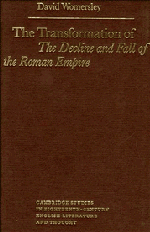Book contents
- Frontmatter
- Contents
- Acknowledgements
- A note on references and quotations
- Introduction
- PART I The historiography milieu
- PART II The Decline and Fall of the Roman Empire
- 3 Introduction
- Volume 1 - 1776
- Gibbon among the philosophers
- Volumes II and III - 1781
- Volumes IV, V and VI - 1788
- 13 ‘A dead uniformity of abject vices’
- 14 Structure
- 15 ‘Not a system, but a series’
- 16 ‘A keener glance’
- 17 Realising the past
- 18 ‘The wide and various prospect of desolation’
- Appendix
- Bibliography
- Index
14 - Structure
Published online by Cambridge University Press: 05 September 2013
- Frontmatter
- Contents
- Acknowledgements
- A note on references and quotations
- Introduction
- PART I The historiography milieu
- PART II The Decline and Fall of the Roman Empire
- 3 Introduction
- Volume 1 - 1776
- Gibbon among the philosophers
- Volumes II and III - 1781
- Volumes IV, V and VI - 1788
- 13 ‘A dead uniformity of abject vices’
- 14 Structure
- 15 ‘Not a system, but a series’
- 16 ‘A keener glance’
- 17 Realising the past
- 18 ‘The wide and various prospect of desolation’
- Appendix
- Bibliography
- Index
Summary
Matter grows under our hands. – Let no man say, – ‘Come – I'II write a duodecimo.’
SterneHistory is a Structure; she demands Order and Connexion as all other Buildings; and her Materials without that, would make but a tumultuous Heap of Sand without Lime.
Le MoyneIn ‘Of the Rise and Progress of the Arts and Sciences’ Hume points out a literary pitfall which lies in wait for the historian committed to investigating causality:
But when the event is supposed to proceed from certain and stable causes, he may then display his ingenuity, in assigning these causes; and as a man of any subtilty can never be at a loss in this particular, he has thereby an opportunity of swelling his volumes, and discovering his profound knowledge in observing what escapes the vulgar and ignorant.
Gibbon's experience is the reverse of this. It is the frustration of his attempts to grasp the causation of history which swells The Decline and Fall, just as the perfected structure of Volume I was the fruit of the certainty Gibbon felt in 1776 about the cause of Roman decline. John Burrow has recorded Gibbon's proud insistence ‘on the coherence of the entire work’. But one must be careful not to press the historian's phrase ‘the unity of design and composition’ too far: as Gibbon uses it, it denotes little more than his resolve not to be seduced irrecoverably from his subject of the Roman empire.
- Type
- Chapter
- Information
- The Transformation of The Decline and Fall of the Roman Empire , pp. 214 - 227Publisher: Cambridge University PressPrint publication year: 1988

